All statistics suggest that Levante should be relegation contenders in La Liga this season. They face 13.9 shots per 90, the most in the league, and have the most expected goals against with 52.26. They also have the highest PPDA with 12.67, meaning opposition usually enjoy longs spells of possession against them. So how are they sitting happily in mid-table in 11th place? The answer is simple, Aitor Fernández. The Spanish goalkeeper has been one of, if not the best keeper in Europe this season.
This tactical analysis will look at how Fernández, often referred to as Aitor, has been able to single-handedly save his team from relegation. We will analyse how he fits into Levante’s tactics, as well as how he compares against the league’s best goalies.
How do we know Aitor has been the best?
In our data analysis of the best goalkeepers within Europe’s top five leagues, we discovered that Aitor had benefited his team the most. Below we can see the goalkeepers that have the best PS xG +/-, meaning the number of goals they were expected to concede, minus the goals they actually conceded.
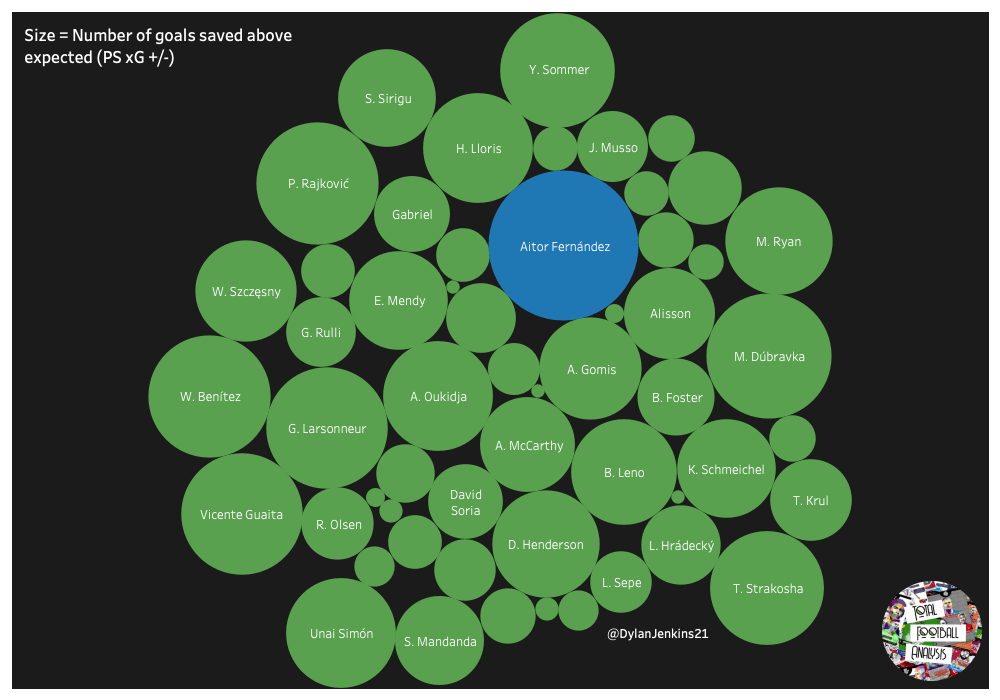
Aitor has prevented the most goals out of every goalkeeper in the top five leagues. The Spaniard has saved 12.5 more goals than he should have, which is truly remarkable. After struggling to get game time in the Spanish top flight in previous years, he has certainly made a name for himself over the past two seasons with Levante.
Along with this, he also faced some of the most difficult shots in Europe (0.31 PS xG/SoT), often saving them. As evident in the graph below.
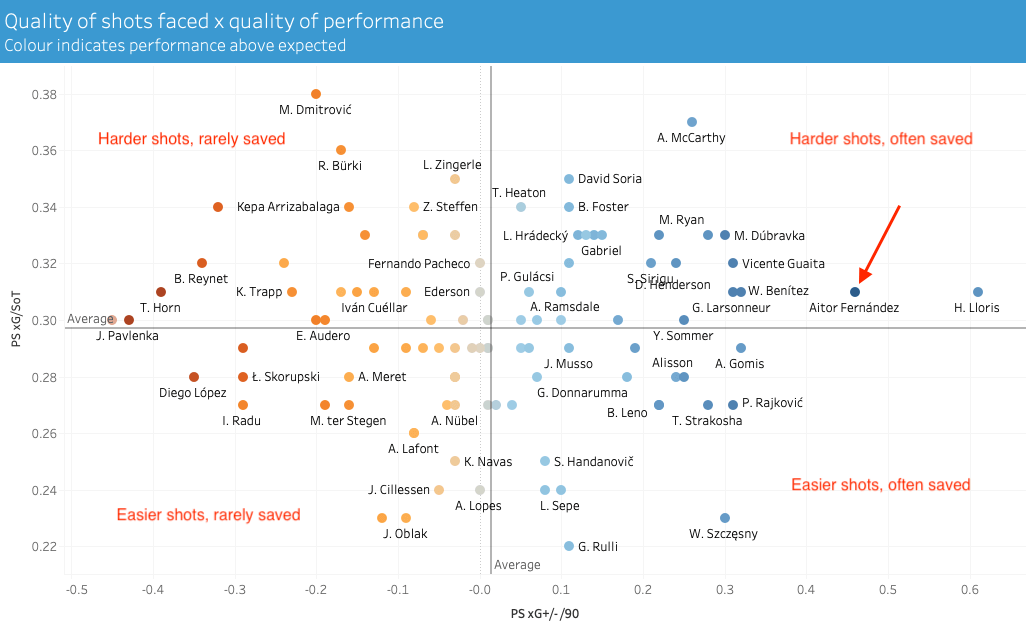
Footwork or height?
Of course, the main priority for a goalkeeper is stopping goals. Aitor has certainly done that this season. He has a PS xG +/- per 90 of 0.46, meaning he saves this many goals more than he is expected to every game. But he has only kept a clean sheet in 14.81% of his games, the third-lowest in La Liga. Despite this, his team would be in big trouble without him.
Unlike previous goalkeepers we have compiled an analysis on, Aitor is very short for a goalkeeper, standing at 1.82 metres. His tremendous reflexes and footwork make up for his small build. The 29-year-old faces a huge 5.93 shots per 90, making 4.20 saves per 90. These stats suggest that he is tested frequently in every game, but is able to prevent a majority of shots.
One of his best saves this season came against Osasuna.
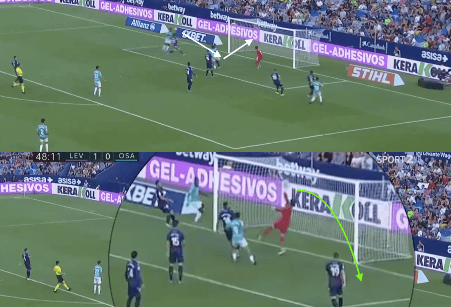
After the opposition stands up a cross to the back post, a goal is almost certain for the visitors. But the attacker heads the ball down, giving Aitor a chance to save. He realises the lack of power on the header and manages to flick the ball over his shoulder out of the goalmouth. His quick reflexes here allowed him to save the ball before it crossed the line. Aitor makes 63.5% of his saves using reflexes, showing just how fast he is to react.
As well as having excellent reactions, Aitor has a great ability to change his save action at the last minute. Saving the ball in the correct way is important in stopping the goal, and preventing a rebound to the opposition. Below is a perfect example.
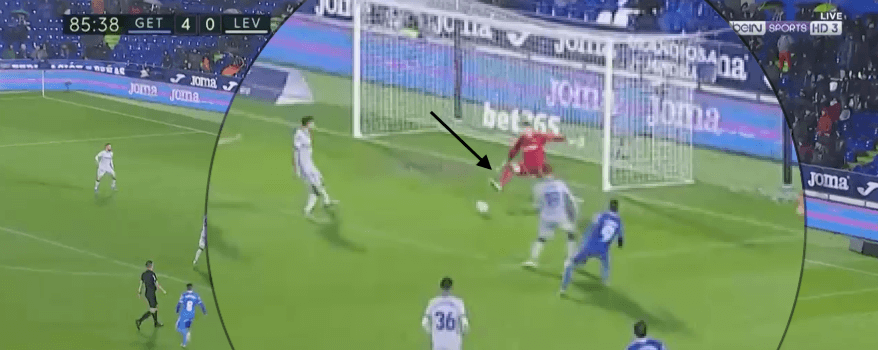
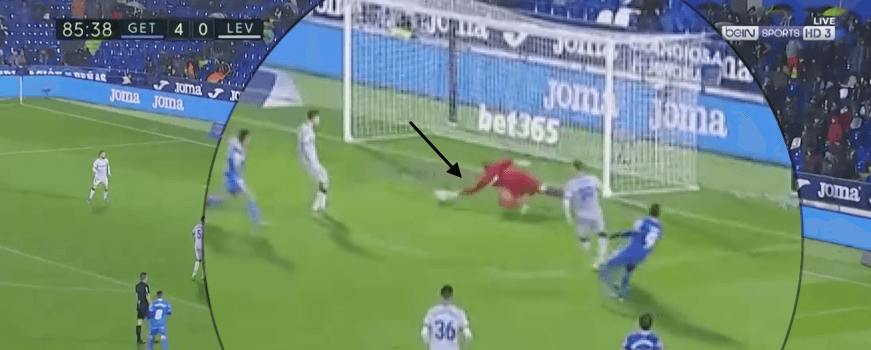
He deals with the first part perfectly, he waits near his goal and prepares to react to the shot. Aitor anticipates well, but the shot is better than he expects. He quickly realises that his outstretched foot won’t reach the ball. Using his superb reflexes, he is able to quickly get his hand down low and prevent the shot from going into the bottom corner. In a split second, he is able to change the shape of his body and type of save to prevent a goal.
Although his reflexes help him prevent a lot of shots that are made close to his goal, his footwork is what helps him reach saves from a distance.
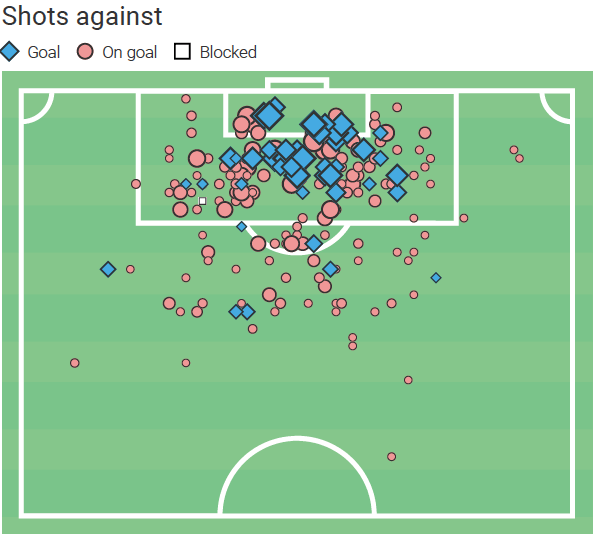
As the above shot map shows, Aitor doesn’t often concede from shots outside the box. This is mostly down to his footwork. Because he doesn’t possess a tall frame like other keepers, he must read the play and move across the goal before diving. He does this really well.
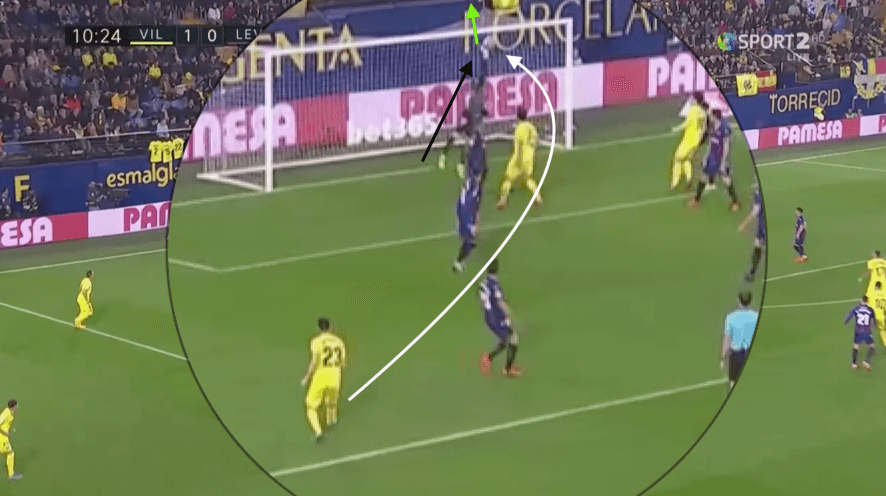
Here against Villareal, after a great pass by former Arsenal man Santi Cazorla, a shot is hit from just inside the box. Aitor is able to read where the shot will likely go by the shape of the shooter’s body. He uses his footwork to swiftly scuttle across the goal-line, and tips the ball over the bar using his right hand. Because of the power on the shot, he doesn’t need to get a strong hand to the shot, therefore the right hand is the correct decision here.
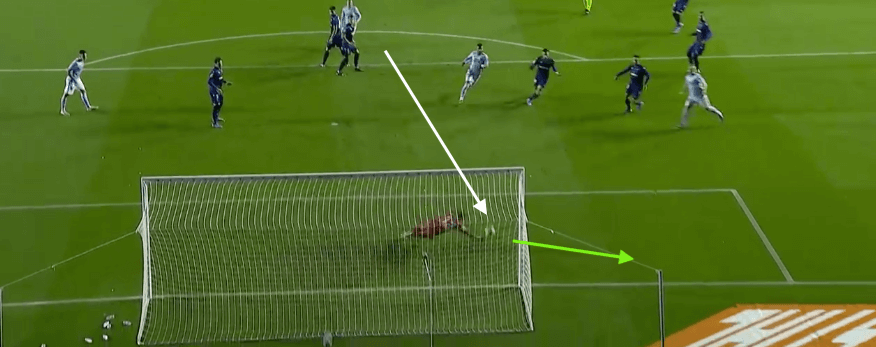
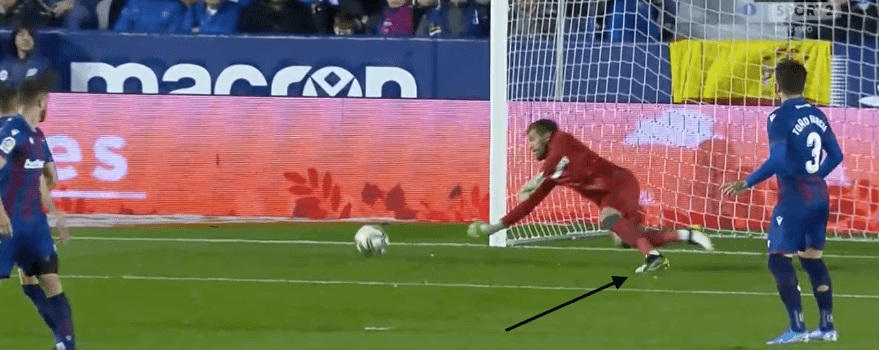
The above save against Celta Vigo is only made because of the Spaniard’s footwork and ability to move across the goal at speed. In the first image, we can see how the shot is going into the bottom corner. But in the second image, we see how, even up until Aitor saves the ball, he is using his feet to move across to the corner of the goal. This great footwork has led to him boasting a 76.61% save percentage – the highest in the league. Aitor also makes 3.03 saves before he concedes, on average. Again, the highest in the league.
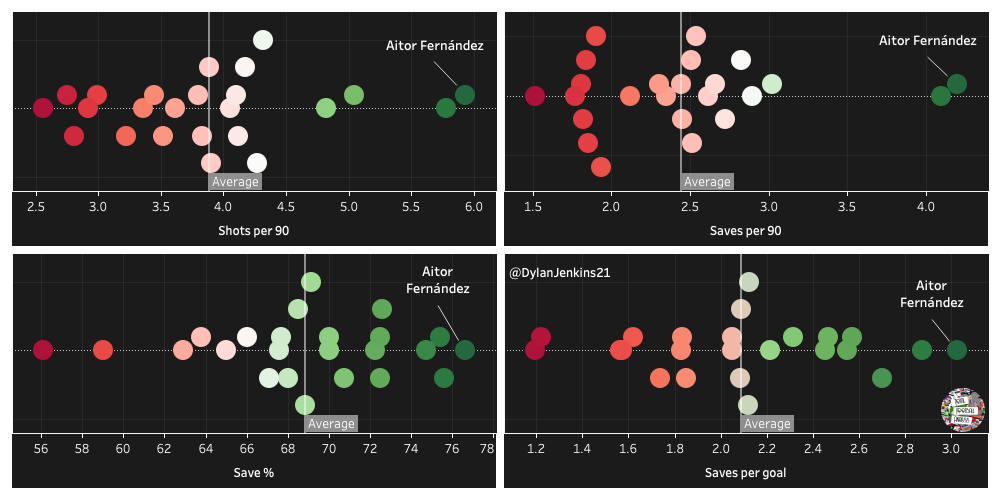
In the above comparison between goalkeepers in La Liga, we can see that Aitor comes out in first in every category. And with goalkeepers such as Marc-André ter Stegen of Barcelona and Thibaut Courtois of Real Madrid playing in the same league as the Levante keeper, it proves just how good he has been this season.
Reading of the game
The main aspect that separates different levels of goalkeepers is their decision-making skills. A goalkeeper can be an incredible shot-stopper, but if they can’t make the correct save in different scenarios then this will harm their game. A prime example is Hugo Lloris. He’s able to make tough saves look good but often struggles to save the easier shots that are closer to his body.
However, a good ability to read the game doesn’t just help keepers with their shot-stopping. Aitor’s fast-thinking and decision-making help him sweep up balls in behind.
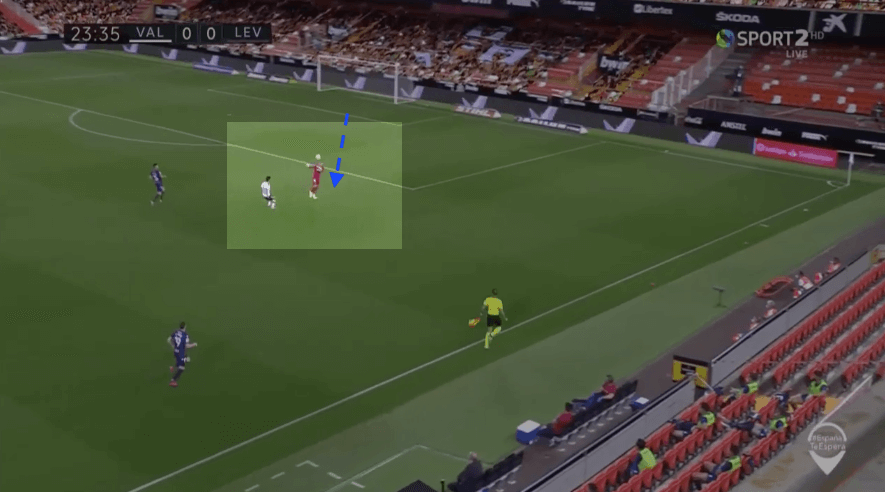
Here, he recognises the danger that the through ball will cause if he doesn’t intervene. He leaves his box and heads the ball to safety, ensuring Valencia don’t gain possession.
A better example is below, against Real Madrid.
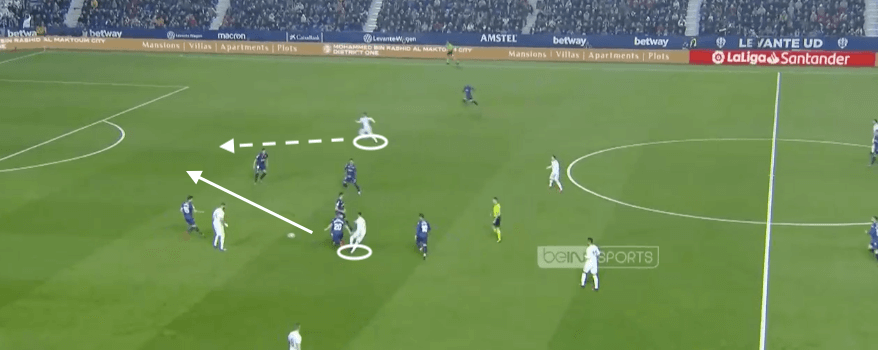
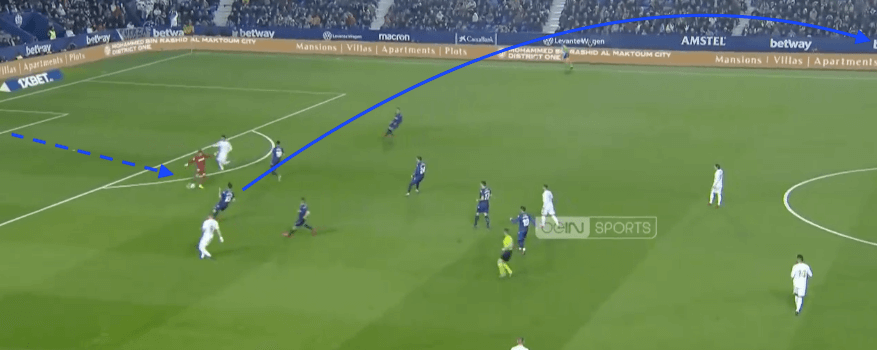
Levante are in big trouble in the first image. The left-back has lost the run of Isco, and Eden Hazard is about to pick him out with a through ball. Aitor reads what is going to happen brilliantly. Because of his high start position and ability to read the game, he can rush out of his box and intercepts the ball. This is just one of the reasons where the Spaniard has single-handedly stopped his team from conceding.
Aitor averages 1.7 exits and 0.81 out of penalty box defensive actions per 90, with an average distance of 14.3 metres.
The Levante shot-stopper often makes the right decision, in the same way, he knows how to deal with one-on-one situations.
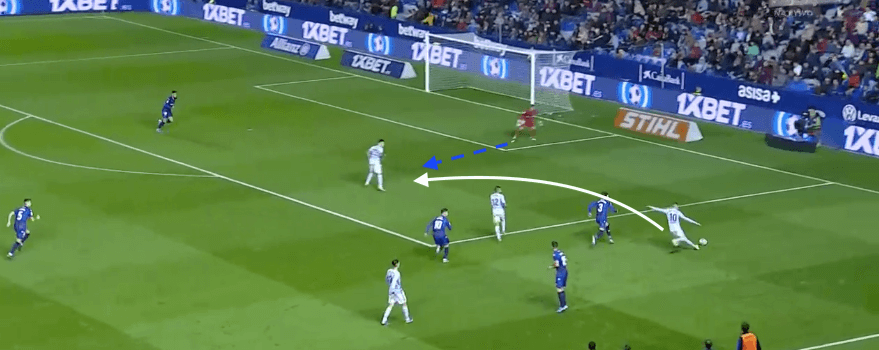
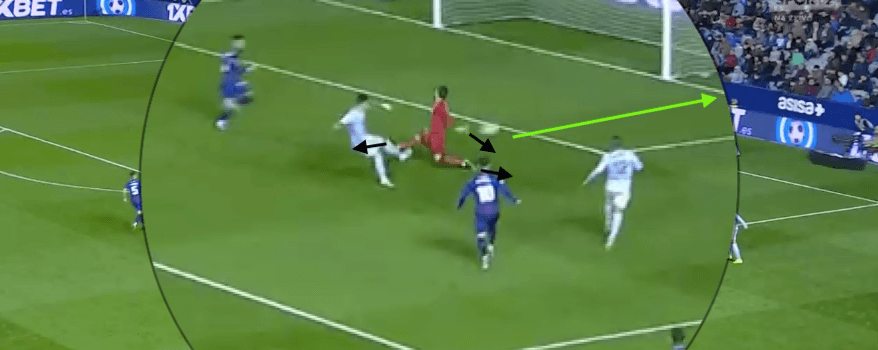
Against Celta Vigo he combines these two skills perfectly. As the winger is running down the line, he notices that the striker in the box is his only option. Aitor uses his speed to quickly close him down and spread himself. Engaging and spreading is a very effective method in this situation. In the second image, we can see that he spreads his body perfectly. Both his legs are outstretched and his arms out by his side, the latter preventing the goal.
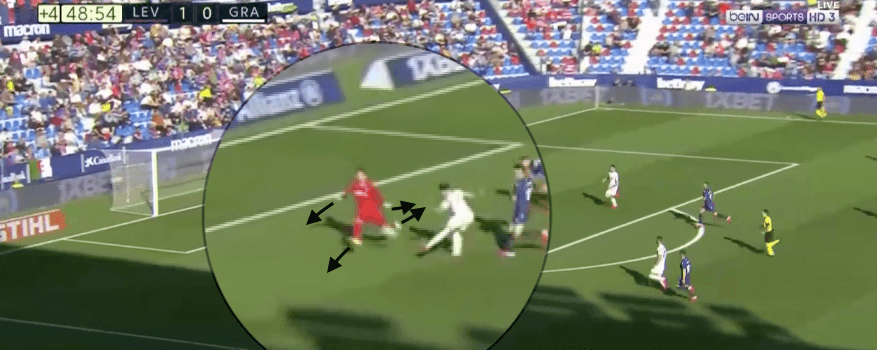
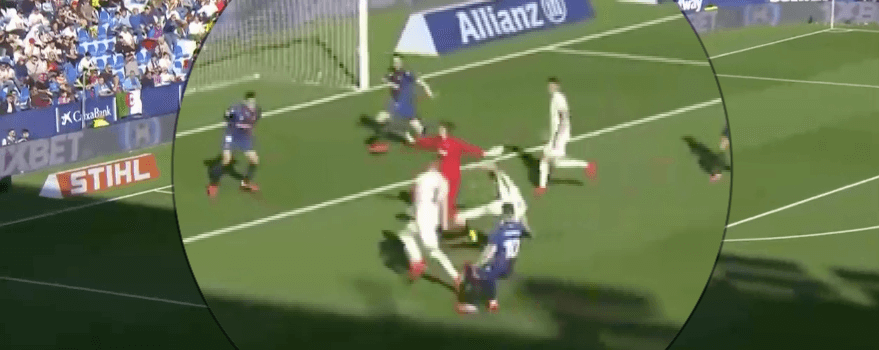
Against Granada, Aitor makes a fantastic double one-on-one save. The first save comes after the Granada man is played through on goal, the Spaniard has to be quick off his line, making himself as big as possible. He outstretches his limbs and saves the initial shot. The second save is a little different because the ball is bouncing. Instead of the traditional spread, he performs the spread mid-air, making himself an even bigger target.
Passing range
Levante don’t necessarily have a passing tactic that they stick to, rather, they play what’s in front of them. This applies to Aitor too, meaning his range of passing has to be good. In terms of stats, he doesn’t stand out, but he does impress in all aspects. Meaning his passing ability is well-rounded. He makes 15.54 passes per 90, with 77.23% accuracy. His average pass length is 42.4 metres, meaning his passes are very mixed in terms of distance.
Here is their typical set-up from a goal kick.
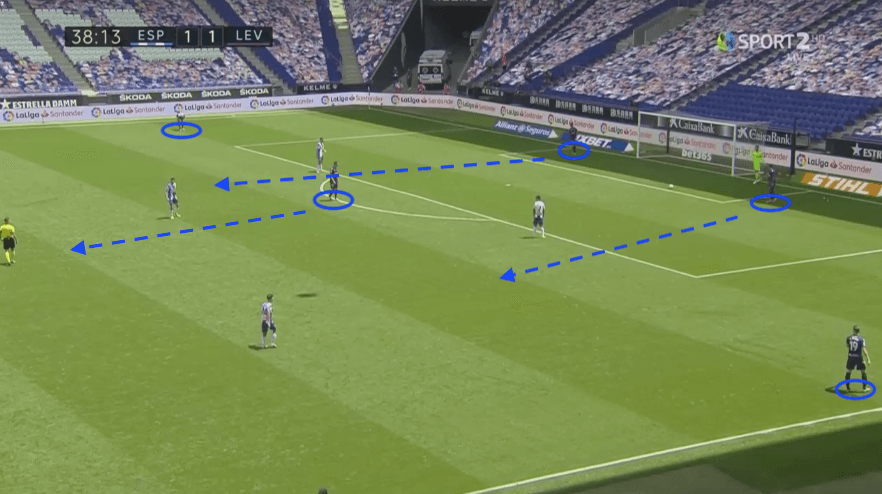
Like most teams that like to play out from the back, they position both centre-backs either side of the six-yard box and their fullbacks out wide to provide width. The defensive midfielder will drop to the edge of the box. However, unlike these passing focused teams, if the pass is risky, they will go long.
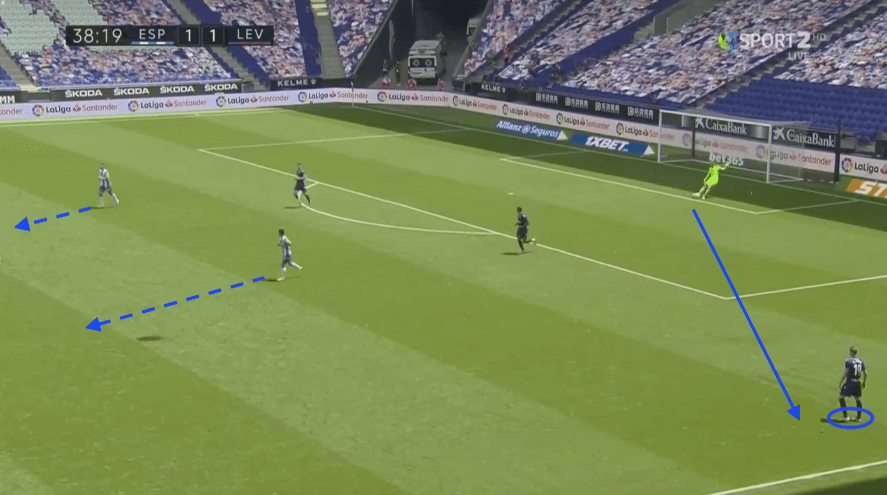
One or both of the fullbacks will stay back to provide a short pass option. The midfielder and centre-backs pushing up will cause the defending team to follow them up the field, giving the fullbacks more space. Aitor launches 53.1% of his goal kick and 52% of his passes – showing that he is capable of passing long and short.
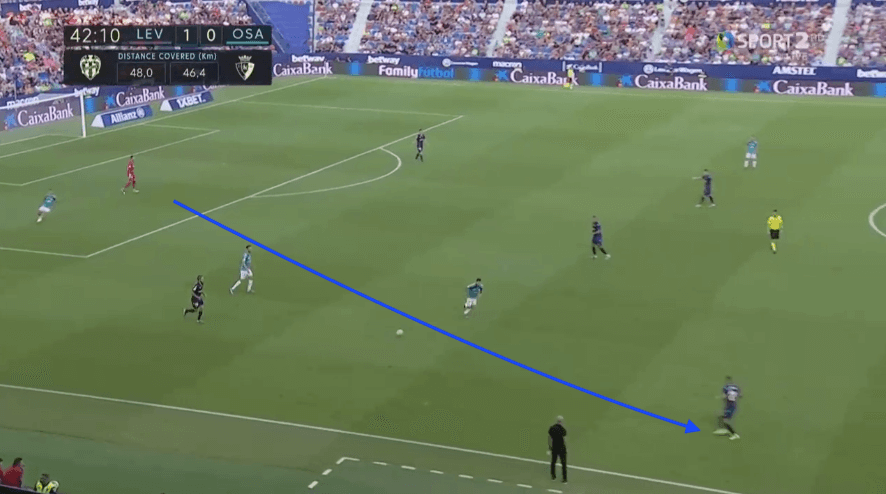
This pass is extremely hard. Firstly his intelligence to spot the pass, and secondly his technique to make the pass is very impressive. He gets enough power and accuracy behind the ball to find his target and start an attack. He splits three defenders with this pass.
As well as this, he is very good at executing a light chip to his target.
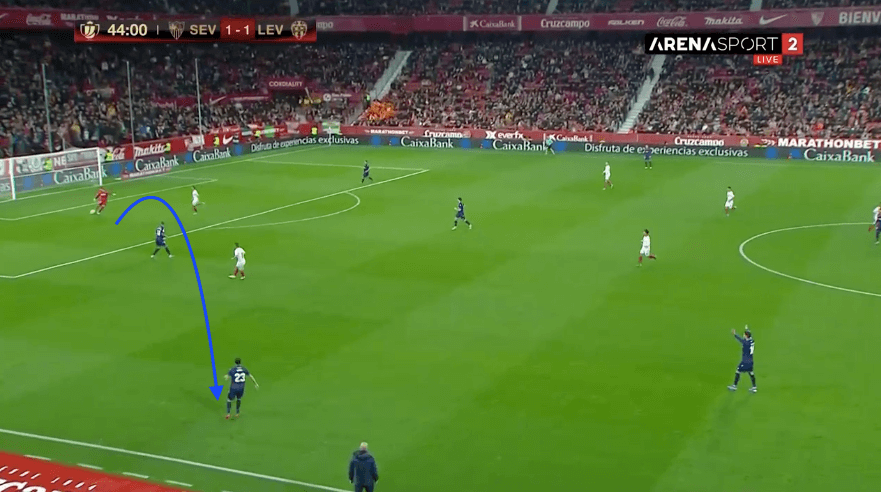
He recognises his teammate in space against Sevilla and finds him with a delicate pass. Because he is in so much space a lighter pass is a more intelligent option as it gives him a higher chance of a better touch. Another example of Aitor starting an attack for his team.
His counter-attacking ability is a great asset to his team. His most effective way of doing so is his kick out of hand. The Spaniard only makes 7.22 long passes per 90 with an accuracy of 55.77% but they are often very dangerous.
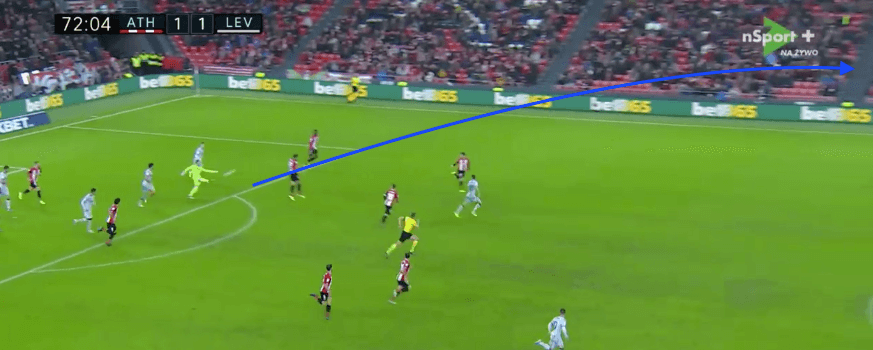
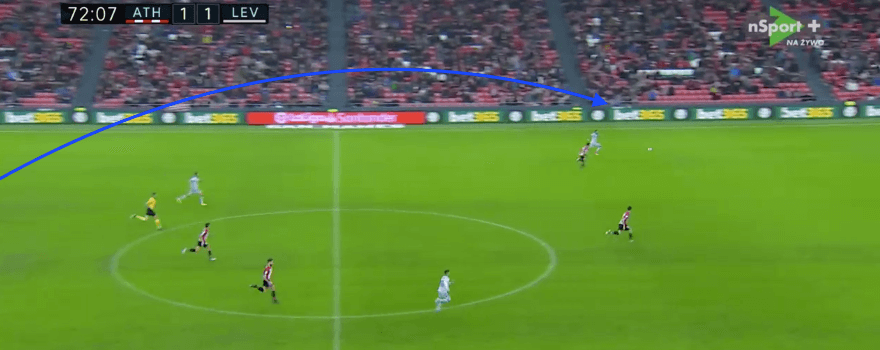
After claiming a high ball against his former side, Athletic Bilbao, he instantly looks to start a counter-attack. He makes a great side volley kick into the path of his teammate. The pass goes about 60 metres because it is such a low and driven pass.
So how does Aitor compare to the rest of the league in terms of passing?
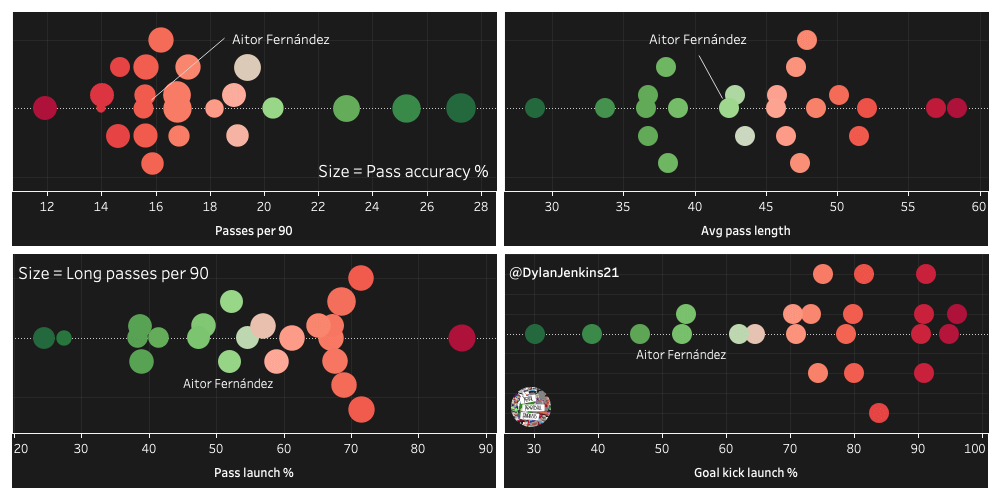
Weakness
No goalkeeper is perfect. Aitor could be put into the category of ‘acrobatic’. He has a tendency to parry the ball when he could easily catch it. This leads to second-phases for the attacking team that can lead to shots.
Although he can’t be expected to catch this shot, he should parry it out of play or to a safer position.
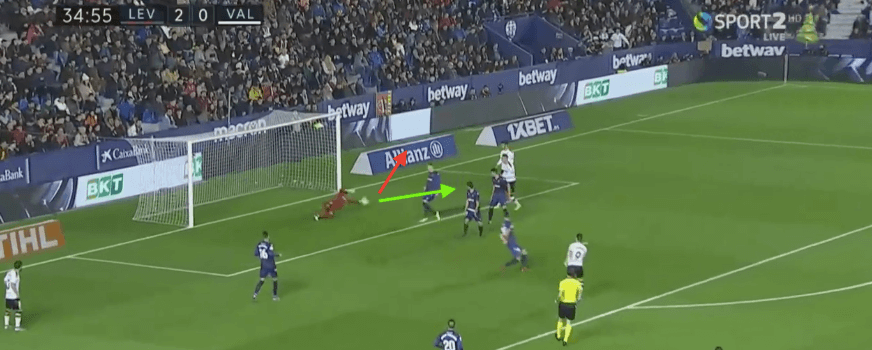
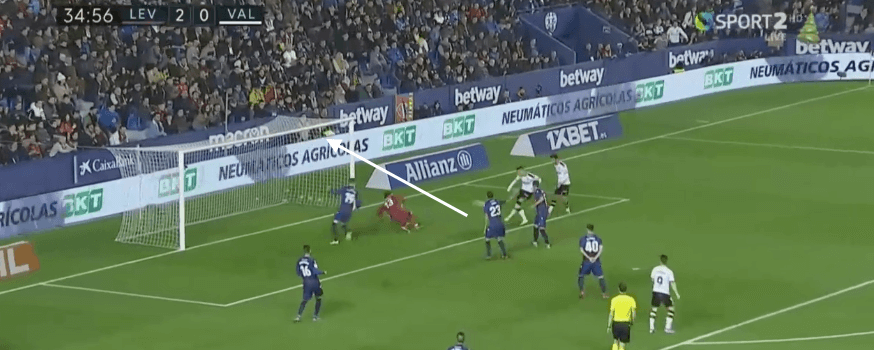
Although the shot is difficult, a keeper of Aitor’s quality should be pushing the ball out for a corner. Instead, the shot rebounds straight to the Valencia striker who fires it into the net.
Here is a more straight forward situation.
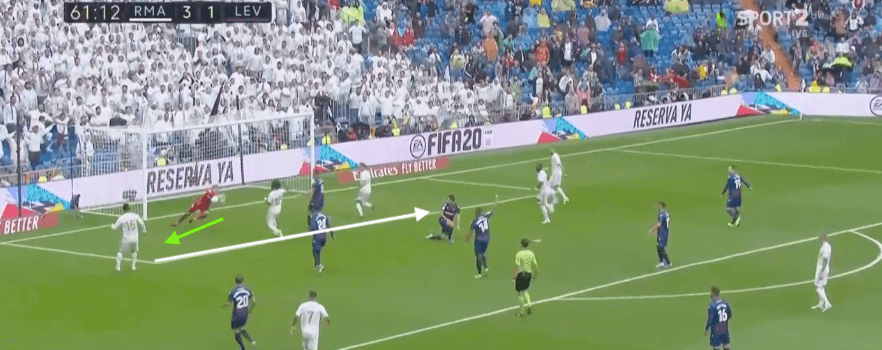
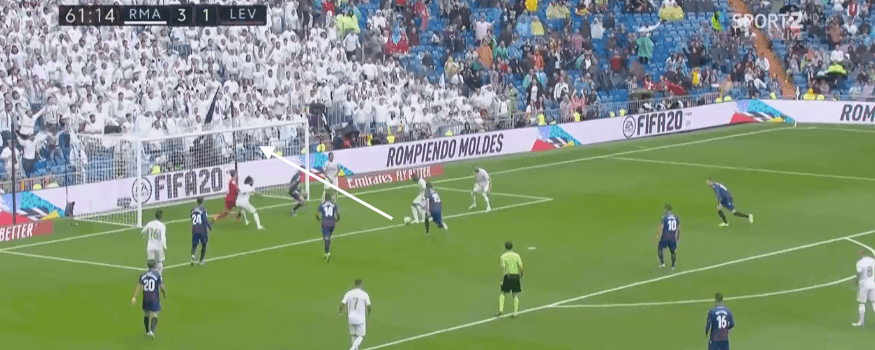
Here against Real Madrid, he faces a very difficult situation. His defence have let him down, there are five Real players around the ball, to Levante’s three. James Rodríguez receives the ball near the six-yard box. Here, Aitor needs to catch the ball, instead, he palms it straight back to James who finds Vinicius Júnior. Alternatively, the Spaniard could rush out to the midfielder and close down the shot, stopping any chance of the ball reaching Vinicius.
Transfer rumours
After such a good season it’s no surprise that there have been plenty of clubs linked with Aitor. However, Athletic Bilbao and Valencia appear to be leading the race. Bilbao already have a very good goalkeeper in Unai Simón, so let’s compare him to Valencia. Valencia have struggled to find a number one keeper this season, Jasper Cillessen has played the most games for them. So how does Aitor compare to him?
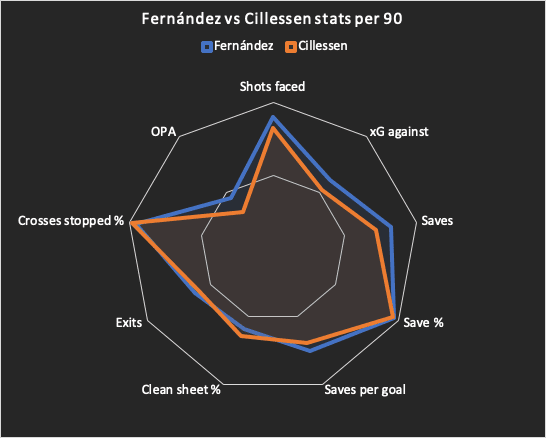
Aitor dominates Cillessen in the above graph. Apart from clean sheet % and percentage of crosses stopped Aitor exceeds the Valencia shot-stopper in every stat. Aitor would sure be a great signing for Valencia.
Conclusion
This scout report has outlined why Aitor has had such a successful season. His footwork and reflexes make him so difficult to beat, especially from distance. His ability to read the game helps him prevent goals from one-on-one opportunities whilst aiding his sweeping skill. But he can get too excited with shots, opting for the more acrobatic save, rather than a safe catch, often resulting in a goal for the opposition. Given a better defence, Aitor would grow to be a better keeper, facing fewer shots per game. Being 29, the Spaniard is in the goalkeeping ‘peak’, meaning he has more seasons ahead of him.




Comments